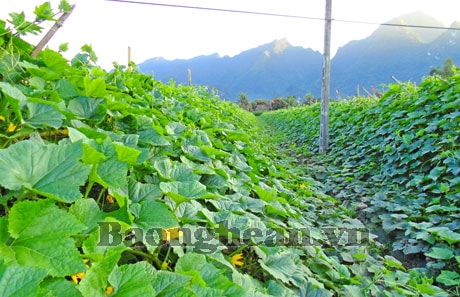Bringing crops to hilly land - A way out of poverty
Adjusting the crop structure appropriately and diversifying crops to suit the conditions of each land area is one of the ways to bring practical economic efficiency to farmers. To exploit the land potential, farmers in areas without enough water to grow rice have switched to growing other crops, which brings high economic efficiency. However, for this model to develop further, people need more attention and support from all levels and sectors, especially the connection of "4 houses" to make the crop more and more sustainable...
(Baonghean) -Adjusting the crop structure appropriately and diversifying crops to suit the conditions of each land area is one of the ways to bring practical economic efficiency to farmers. To exploit the land potential, farmers in areas without enough water to grow rice have switched to growing other crops, which brings high economic efficiency. However, for this model to develop further, people need more attention and support from all levels and sectors, especially the connection of "4 houses" to make the crop more and more sustainable...
Talking about the effectiveness of choosing watermelon, squash... to replace rice crops on hilly land, farmers in Hoi Lam and Ha Du villages (Cam Son commune, Anh Son district) affirmed that growing vegetables gives a more stable income than growing rice. In fact, in recent years, many areas of rice crops on hilly land have been damaged by drought, resulting in total loss. In recent years, people have been excited to plant watermelon, cucumber, squash, and pumpkin because of the good harvest and good prices.
Mr. Tran Quoc Tuan - Secretary of the Cam Son Commune Party Committee revealed: "In recent years, the commune's policy has been to plant crops on the hillside land, replacing rice, mainly watermelon. It only takes 50-55 days from sowing to harvest, each hectare yields 50-60 million VND, 5-7 times more than growing rice. For many years now, people in the commune have earned billions of VND every year thanks to converting and planting crops on the hillside land."

People in hamlet 2 - Dinh Son commune (Anh Son) bring squash plants into the hillside fields.
for income of 50 - 60 million VND/ha/crop.
Hoi Lam villagers said: Starting in January, people plow the land into beds to plant squash, cucumbers, pumpkins... after nearly 3 months of harvesting. With the price of squash at this time from 8,500 - 10,000 VND/kg, after deducting expenses, they still earn a profit of about 45 million VND. After harvesting squash, they continue to plant watermelons. After harvesting watermelons, they replace them with eggplant and mustard plants. Just like that, if the weather is favorable, a year can yield 4 crops for sure. One hectare of hillside land can now earn 150 - 200 million VND/ha.
Bringing crops to the fields in difficult areas is considered a good way for farmers. To help farmers carry out successful production, agricultural extension officers must regularly open training classes on care methods, application of science and technology and disease prevention. And the important thing is to change old production practices, because growing crops requires more adherence to the fields and crops than growing rice.
The model of bringing color into the hilly land in Cam Son has been effectively followed by farmers in neighboring communes such as Dinh Son, Tuong Son or Bong Khe, Chi Khe (Con Cuong). The area of flower cultivation in Cam Son commune alone has reached hundreds of hectares.
Thus, it can be seen that the application of the model of bringing color into hilly land in areas with difficult conditions in many localities in the midland and mountainous areas in recent times has brought about practical results. With the model of crop rotation bringing an average income of 50 million VND/ha/crop, the value of hilly land use has reached a super-profit level of 200 million VND/ha/year.
An important thing is that bringing crops to the hilly land not only changes habits, makes people more diligent, reduces idle time, and brings high income. This is both a solution to change the crop structure and a way for farmers not only to escape poverty sustainably, but also to rise up to become rich right on the dry land. In the immediate future, it is necessary to organize training for people. Localities that have not been able to do it should organize for farmers to visit and study, in order to gradually replicate the highly effective model, so that people can see with their own eyes, do it directly and learn to follow it.
In addition, the application of crops on hilly land also helps to improve the soil, keep the soil loose and fertile, and limit the abandonment of fallow land due to drought and lack of water. All levels and sectors need to advise farmers on output for sustainable production.
Phung Van Mui (Con Cuong)






